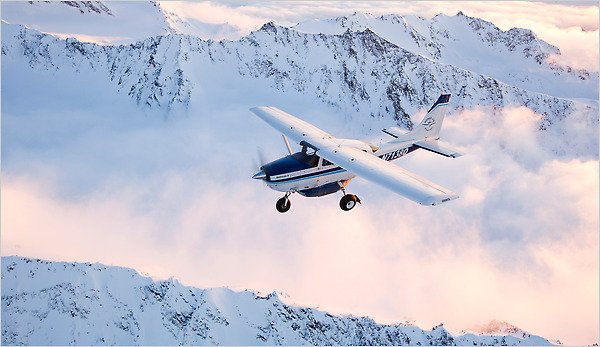Permission to Fly
By Kurt Mullen
Originally Published on Airplane Reading
One thing nice about space is it keeps going.
—Willem de Kooning, 1959
We landed in my brother-in-law’s plane at the Knik Glacier, 50 miles east of Anchorage. There’s no highway thrum, no over-passing airliner here, and when Kenny and I walk along the edge of this 25-mile long ice field, I can hear the leaves falling frozen from a bush. In moments we’re back above it all, flying over a turquoise glacial waterway, into a kind of arctic canyon with ice walls 150-feet high.
This was the smoother part of my first flight in Alaska, five years ago. Most of the turbulence that day was in my head, as I worried about being a passenger in such a small plane. But on a hike the other night in the Chugach National Forest here in Anchorage (where I’m back visiting my wife’s family) someone summed up the problem of getting to know Alaska, a place so massive, mountainous, and wild: “So much of the state you just can’t see unless you pay someone to fly you, and that’s expensive. Or if you’re lucky enough you can fly yourself.”
Or you have a pilot brother-in-law who’ll take you.
That this was good fortune, however, took me several years to realize.
The first time I saw Kenny’s plane, in 2000, it was in winter storage in the garage of his house in Anchorage. Its wings were folded back among the trash cans, the bikes, and the bin of kibble for the dogs. To me, it was extreme DIY’ing, that Kenny had assembled the plane himself, as you would a lawnmower or a kitchen table. The wings were made of fabric and the two-seater cockpit had a laminated plywood floor, and it was all so much like a go-kart.
I know that fear is what keeps us all safe. But your nervous system throws up thousands of red flags every day and what is life like if you yield to all of them? For me, it goes beyond flying in Alaska, and back into my everyday life. It’s a concern, for instance, when I’m not telling the more difficult stories, the ones that might not make me look good, but that a reader can relate to.
It took five years to ask Kenny to take me flying. I think I was just tired of not doing it, of being the guy who didn't go. When he took me to Merrill Field in Anchorage, it was a cold September morning, and the wings of his red Kit Fox were white with frost.
Since this was not a 747 at Chicago-O’Hare, we had to do our own de-icing. For this, Kenny came back from his truck with a t-shirt, and we balled it up and took turns rubbing the wings. This seemed completely insane to me and, rubbing, I waited for Kenny to say the same; to call it ridiculous, to call it a day.
But with help from the sun the frost was gone in 30 minutes. Kenny hopped into the cockpit and told me to keep clear of the propeller.
He turned the key a few times and got no response. It was irritating that the engine wouldn’t start. To him, that is. To me, on the asphalt at Merrill Field, it was a reprieve. The frost had made me anxious, and my short term gameness had run its course. I didn’t want to go. This was not for me. Now the engine wasn’t starting and I didn’t have to say it. I was lucking out. I was off the hook.
But that’s not the way it goes here; Kenny wasn’t giving up. He was pulling his truck close to the plane. Then what? He was connecting truck and plane with jumper cables. This was even more absurd than defrosting with a t-shirt, and I was hoping it didn’t work.
But it was just a matter of getting the battery going, and when Kenny did this the propeller snapped to life. He waved for me to come on, and I walked toward him, past a number of red flags that shot up in my head. I climbed into the plane and in that moment, like the propeller, I too got the chance to snap to life.
This weekend I was back in Kenny’s plane, hanging 2,000 feet over Anchorage, and as we moved away from the asphalt city, I saw how quickly the landscape grows wild and beautiful. It was the middle of a sunny afternoon, I’d run a half-marathon in the morning and I was feeling very much alive. I was happy to leave the drama down below, to the landscape that is so dramatic, to the land you just can’t see from a car.
